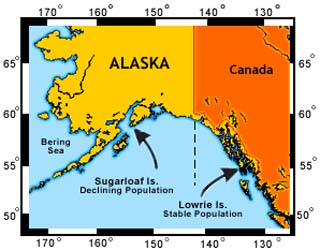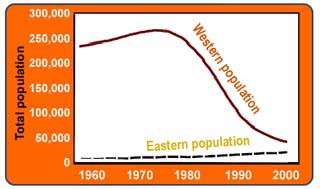 |
| back
to data |
|
|
|
| Steller's
sea lions are found around the North Pacific Ocean rim from northern Hokkaiddo,
Japan through the Kuril Islands and Okhotsk Sea, Aleutian Islands and central
Bering Sea, southern coast of Alaska and south to the Channel Islands, California.
The shaded area shows the extent of their distribution. |
|
|
| Figure
1. Map of Steller's sea lion distribution across northern Pacific
Ocean including Bering Sea and Okhotsk Sea (nmml.afsc.noaa.gov/AlaskaEcosystems/sslhome/distrib.htm) |
|
|
|
|
 |
| Figure
2. Division of Steller's sea lion population in Alaska. (www.marinemammal.org/whatsnew/2003/foodshortages.html)
|
|
|
Steller's
sea lion in Alaska are divided into two distinct populations. The division
between the western and eastern Steller sea lion populations. is shown by
the dashed line at the 144Ê longitude (Figure 2). While they are the same
species of sea lion, the two populations do not intermingle.
(Milette
and Trites, 2003)
|
|
Figure 3 is
estimated
numbers of Steller's sea lions (all ages) in Alaska from 1956 to 2000.
There was a rapid decline in
western sea lion population from the 1970s to 80s. This population was
still declining in the 1990s, but at
a much slower rate. Meanwhile,
the eastern population may have been increasing slowly during this same
time period.
Think
about the geographic location of the declining versus the stable populations.
(Trites
and Donnelly, 2003; www.marinemammal.org/whatsnew/2003/nutritional_stress.html)
|
 |
| Figure
3. Population of two Steller's sea lion stocks in Alaska. (from
Trites & Larkin, 1996; A.W. Trites, unpublished data)
|
|
|
|
|
| Table
1. Reductions in axillary girth
and weight in Steller sea lions aged 1, 7, and 14 in 1985-86
as compared to 1975-78. |
| Age |
Reduction
in axillary girth (%) |
Reduction
in weight (%) |
| 1 |
10.4 |
26.9 |
| 7 |
6.29 |
12.3 |
| 14 |
1.7 |
3.0 |
|
|
Density-dependent
population theories suggest that body size should increase as population
density decreases since there are per capita food increases. Table
1 shows that there was a noticeable drop in sea lion length and weight
from the 1970s to 1980s. Contrary to the theories, population growth rate
was declining during this time period.
-
What could be causing this inconsistency?
(Trites
and Donnelly, 2003)
|
|
Table 2 compares
the composition of food contents and scats in Steller's sea lions on Kodiak
Island during three decades. It reveals that there was a shift in diet
for sea lions in the declining population from predominantly small schooling
fish to Gadids.
-
What caused this shift, and has it been a change for the better?
(Trites
and Donnelly, 2003) |
| Table
2. Proportion (%) of Steller's sea lion scats and stomachs containing
five prey categories during the summer months in the declining
Kodiak Island region in the 1970s, 1980s, and 1990s (Merrick
et al., 1997) |
|
Gadids
|
Salmon
|
Small
schooling fish
|
Cephalopod
|
Flatfish
|
| 1990-93 |
85.2
|
18.5
|
18.5
|
11.1
|
13.0
|
| 1985-86 |
60.0
|
20.0
|
20.0
|
20.0
|
5.0
|
| 1976-78 |
32.1
|
17.9
|
60.7
|
0.0
|
0.0
|
| Gadids
= walleye pollock, Pacific cod, Pacific hake; small schooling
fish = capelin, Pacific herring, eulachon, Pacific sand lance;
Flatfish = arrowtooth flounder, rock sole |
|
|
| Table
3. Conclusions from studies investigating various physiological
and behavioral causes for declining sea lion population, 1970s
to 1980s (* studies conducted with sea lions in 1990s) |
| Variable
|
Evidence |
| Birth
weight & growth rates |
Insufficient
data to conclude a reduction. |
| Reduced
pup survival |
No
evidence of high pup mortality. |
|
Reduced
juvenile survival
|
Reduced
numbers of juveniles returning to rookeries of birth in 3-4
years for mating; reduced proportions of juveniles relative
to adults at haulouts & rookeries. |
|
Blood
parameters
|
Blood
chemistry test inconclusive. Haptoglobin levels (blood protein
that increases markedly in response to infection, inflammation,
trauma or tumors) in the western population is significantly
high. |
|
Behavioral
& physiological modifications*
|
Maternal
attendance patterns & foraging behavior suggest sea lions
in declining population were not food-limited during summer
months. |
|
|
Table
3 summarizes conclusions from studies exploring physiological or behavioral
causes for Steller's sea lion population decline in Alaska. The results
show that there has not been evidence of high pup mortality, but there
has been a decline in juveniles returning to rookeries for mating. Blood
tests show that sea lions in the western population may be experiencing
tramatic activities, but this is inconclusive.
Sea
lion and sea otter populations in Alaska are both declining. Consider
the geographic location and the time frame of
the population declines.
- Where
is the geographic range of population decline for the two marine mammal
species?
- How
do the time periods for the population declines relate to one another?
- Can
the cause for sea lion population decline correlate with the sea otter
decline?
(Trites
and Donnelly, 2003) |
|
Table
4 compares the nutritional value of fish that are both eaten by sea lions
and harvested by fishermen.
- What
do you think has caused the decline in the western sea lion population?
- Could
it be a nutritional factor, i.e. the western population of sea lions
are not as well nourished as those in eastern Alaska?
|
| Table
4. Partial composition analyses and energy densities of
herring and common gadids (Walford & Wilber, 1955; Perez,
1994) |
|
Oil
(%)
|
Protein
(%)
|
Energy
density (kJ/g wet mass)
|
| Pollock |
0.8
|
20
|
4.66
|
| Cod |
0.4
|
17
|
3.95
|
| Whiting |
0.4
|
17
|
-
|
| Haddock |
0.3
|
18
|
-
|
| Herring |
11.0
|
19
|
8.61
|
|
|
| back
to data |
|
| |
|
This web
site was created by Lynn Tran at the North Carolina State University, Department
of Mathematics, Science, and Technology Education on 7/12/03. Faculty advisor
Dr. David Eggleston, NCSU, Department of Marine, Earth, & Atmospheric Sciences.
Last updated
December 29, 2003
.
|


